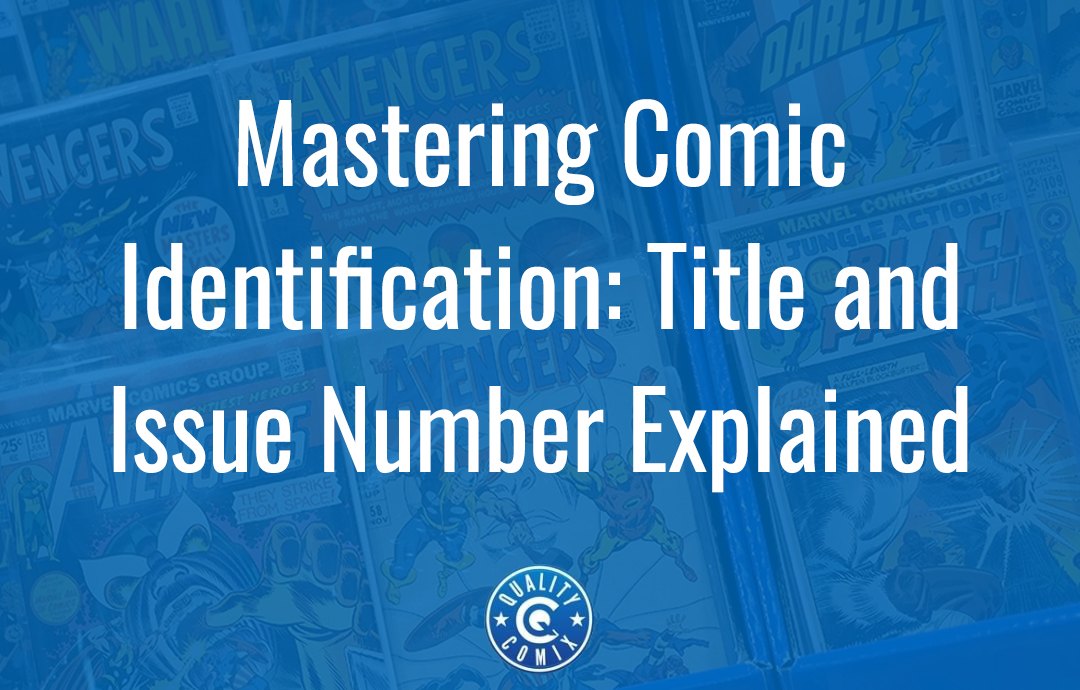
The most critical part of any collectible is making sure you know what you have. Whether you're buying or you're selling, you want to make sure you know what, exactly, you're talking about.
At first glance, it doesn't seem like it would be that difficult. So, pop quiz: what's going on with these scenarios?
- These two versions of TMNT #1.
- These two versions of Star Wars #1
- These two versions of Action Comics #1
Have you examined the comics and made your guesses? Here are the answers.
- One of those TMNT issues is counterfeit. Since TMNT was a very limited run on amateur printing equipment, it's really easy to reproduce compared to many other comics. Interestingly, even counterfeit TMNT #1 can have value, just much less than an authentic copy.
- Note the price in the box in the corner; one is 30 cents, the other is 35 cents. This issue was printed in an era where the publishers were experimenting with price increases, and the higher price issue was only sold in a limited test market, making it a rarer (and often more desirable) copy. This is one of many examples of price variants throughout comic history.
- One clearly has "50 years" on the corner of the cover, indicating it's a reprint, so the other is surely an original, right? Not quite. Original Action Comics #1s are very rare to find in even halfway so good a condition. The version on the right is a different, earlier reprint. Identifying reprints – and which reprints have value – is a critical skill in comic identification.
This should give you an idea of what you're in for as you read the rest of this post. The devil is in the details, and when the details can be the difference between a comic worth $1 and a comic worth $10,000, it's really important to get those details correct.
Now, I'm not going to go super deep on all the little variations and details of comic identification today. I put a few extremely detail-oriented examples front and center to show you that what I'm going to cover is just scratching the surface and that research is crucial for proper identification. Luckily, the internet has made it easier than ever, which is also something I'll cover a bit later.
The truth of the matter is, identifying comics is as much of an art as it is a science. There are no solid rules that cover every circumstance, and there are plenty of comics that people try to pass off as originals when they aren't, and sometimes the tells are very subtle. When in doubt, talk to an expert, whether it's online or at a local comic store.
Table of Contents
Evaluating the Title of a Comic
The start of identifying any comic is with the title on the cover. Unfortunately, even this can be deceptive. Here's another set of examples.
This comic is a good example to start with. At first glance, you'd probably assume this comic is called Ghost Rider. After all, that's the name plastered across the top of the book, right? Well, this is because comic publishers spent a long time creating big, flashy title pages for characters to see if they stuck but would abandon them if they didn't; meanwhile, the whole line was published under one cohesive name.
In this case, above "Ghost Rider," you can see the real name of the comic: Marvel Spotlight. The whole Marvel Spotlight series rotates through characters, but they all have the same Marvel Spotlight title above the characters.
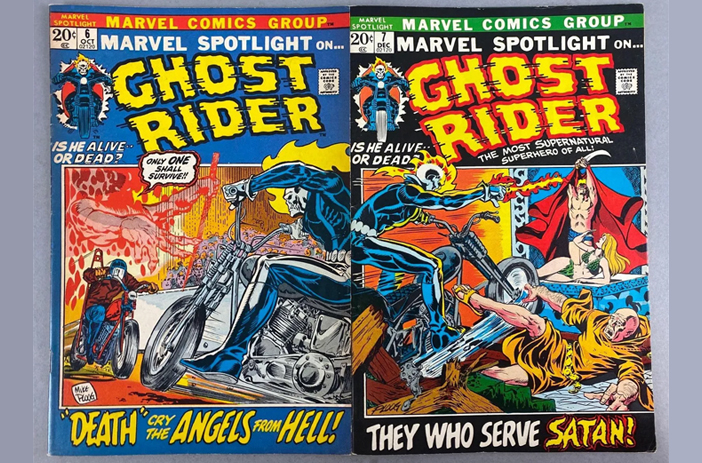
Image source: Google Images
Another example comes from everyone's favorite bat-themed family of superheroes. This one, similarly, looks like it might be called Batman and Batgirl. But now that you know about that primary title, you can see this one is actually Detective Comics.
Now, what about this comic? No, it's not from a line called "King Size Special," but that's important information to know. It's an Avengers Annual issue, as part of the non-mainline Avengers comics, with additional content and stories not told through the normal books. Many comic lines, especially the popular ones, have annuals, specials, "Giant-Size" compilation books, and more. One of the keys to identifying these is that they tend to have low issue numbers since they were released once a year instead of once a month.
It's also important to note that there are a lot of curveballs out there. Dell comics are a big one. Check out these three books:
At first glance, these have nothing in common. They're all books published by Dell, but they feature different characters and different stories. What's the through-line? Well, Dell is your hook here. Dell actually published their comics all under the banner "Four Color Comics," and those three books are #732, 733, and 734. Sequential, even though they have nothing to do with each other!
What About Issue Numbers?
Comic issue numbers are nonsense, as often as not. A big example of this is Marvel's Legacy event from 2017. What's the scoop?
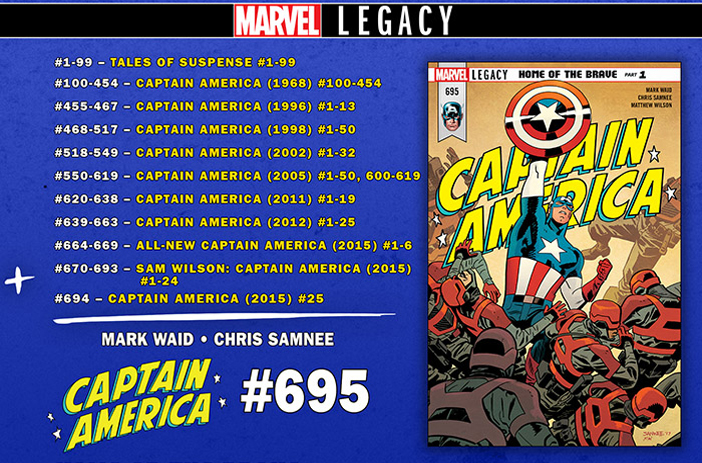
Image source: Google Images
For one thing, many characters were featured as side characters in previous books and lines and may not have had more than a miniseries to their name in decades before they got their own books. Issue #1 for a line might be the third, fifth, 75th, or whatever-th issue featuring a character.
This is made worse by publishers like Marvel trying to look back, assign through-lines for continuity through specific characters, and assigning new numbers for new book lines. The first issue of a new Cable series might start at #150 because they count all the books he was in before and tally them up. Different characters and different lines have different tallies, and it's all just kind of put together by the people at Marvel. Sometimes it reflects the way collectors have viewed a continuity, but other times it didn't, and there's not really much consistency.
That said, when an issue says #150 or #745 or whatever on the cover, that number is often good enough to identify the comic. Other publishers have their own ways of tallying issue numbers, but when there's a number on the cover, that's the number people use to identify it.
Using Old Dates for the Same Numbers
One thing you're likely to encounter when you're plugging comics into a database is that there may be more than one, more than two, or more than several comics with the same issue number.
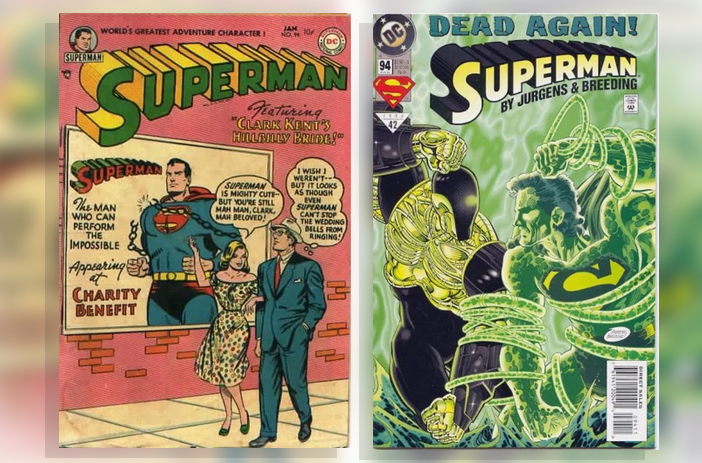
Image sources: Google Images, Superman Volume 1 Issue #94, Superman Volume 2 Issue #94
For example, say you have a comic named Superman, issue #94. What series of Superman is it from?
- You have Superman #94 from Volume 1, also known as Superman 1939. This is the original Superman comics line that started in 1939, so even though issue #94 was published in 1955, it's still part of Superman 1939.
- Alternatively, you have Superman #94 from Volume 2, also known as Superman 1987. This was a new string of Superman comics starting in 1987.
Things get even clunkier here because Superman Volume 1 was discontinued in 1986, and Volume 2 took over. Volume 2 was then discontinued in 2006. So Volume 3 started up there, right? Well, as much as that might make sense, that's not what happened. Instead, DC restarted Volume 1 and picked right up where they last left off, with Superman #650.
Luckily, these all look pretty different, and a quick glance at both the publication date and the image on the cover can show you what one you're working with.
Decoding Barcode Technology
For more modern comics with barcodes, you'll often see two barcodes in the box. The big one is the usual barcode, but we're more interested in the smaller one next to it. This barcode has a five-digit number above it, which will be something like "15011" or "00131". This is a pretty handy number once you know what it means.
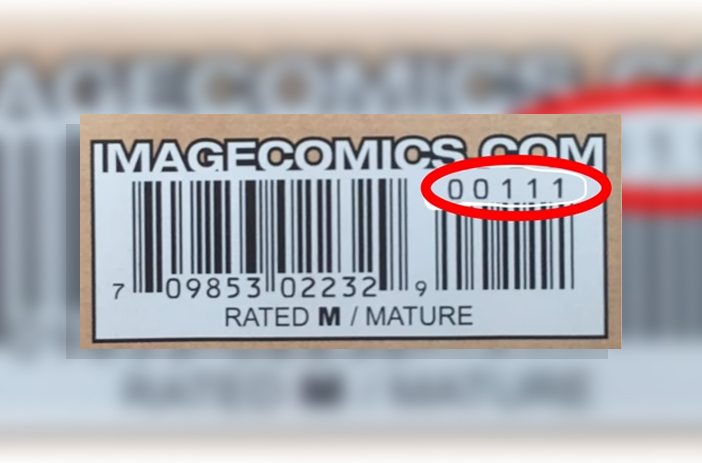
Image source: Google Images
This number breaks down into three parts: the first three digits, the fourth digit, and the fifth digit.
- First three: the issue number. Issue #150 of a comic would be 150; issue number 1 would be 001. For long-running weekly series where they're likely to exceed 999 issues, they often switch to the year and the number for the year, so 332 would be the third year's 32nd issue.
- Fourth digit: This is your variant identifier for comics with official variants. A 1 means it's the first or only variant. A 2 might mean it's the second variant, and a 3 means a third, and so forth.
- Last digit: This is your printing. When a publisher does a print run, all of those comics are given the number 1. If they then have to do a second print run, they increment the number. This is for identification and for quality control; if something goes wrong with the printing, there's an easy way to identify the affected issues without needing to open them all up and find the affected portion.
So, a comic with a barcode 15011 would be the 150th issue, primary variant, first printing. 00131 would be the first issue of a series, third variant cover, first printing. 00112 would be the first issue of a line, primary cover variant, second printing.
Older comics, of course, don't have this mini-barcode, so you don't get any of that information. These usually started cropping up when variants and reprints became much more common, primarily around the 90s. And sometimes, there's something even more obvious, and you can just look at the cover.
Shortcuts to Identifying Comics
There are a ton of little quirks, details, and caveats to pretty much everything when it comes to comics. It can be tricky to identify a comic, even in broad strokes, if you're not familiar with the industry. Of course, plenty of people inherit comic collections and want to sell them, and collectors may buy bulk and need to scan through them quickly, so there are definitely options available to shortcut most of the identification process.
The first step is a rough sort. Identify comics based on era, which you can do by looking at things like the cover price, publication date, and even art style to an extent. The older the comics are, the more likely they are to be valuable, and from there, you can focus your energies on identifying the most important comics to ID.
One shortcut is to use an app. There are quite a few phone apps out there for both iOS and Android. Some of them scan barcodes and look up the information in their databases. Some of them only do keys, while others try to be as comprehensive as possible. Still others try to use image recognition to identify comics. You need a phone with a functional camera to use the apps, but they can come in handy for categorizing comics quickly.
The second option is to get the important-seeming comics graded. Grading costs a bit of money, but it can add to the value of your comics, so they sell for even more when you want to part with them. Plus, the experts at CGC or whatever other grading agency you use are very familiar with comics and their variations, so they can identify which ones are which.

A third option, and the one we recommend the most, is to talk to some experts. In fact, wouldn't you know it, we're experts! All you need to do is take some pictures and describe your collection, and drop us a line. We can estimate the era, rough values, and general identification of the collection. We can also point out if there are any specific variations or noteworthy printings you might check for. And, of course, we can recommend what the best options are to dispose of your comics, whether you want to sell them ASAP or take your time to get your money's worth out of them.
Consulting with us is free, with zero pressure, and no obligation. We love talking about comics, checking out collections, and helping out other fans. Just say hi, and we'd love to chat.



